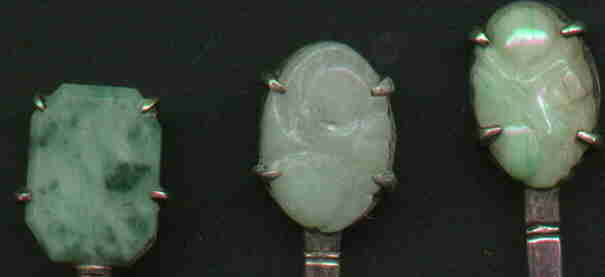
The oriental countries of China, Hong Kong, Japan and others have produced gemstone spoons in their own unique styles.
They have used a wide variety of different minerals, but for the most part they prefer to use either jadeite or nephrite. Both of these minerals are referred to as "jade", but jadeite is a prettier and more expensive stone.
The Oriental's also like to carve gemstones. This is a very difficult art and has not been used in the West for over 100 years. When many of these spoons were made, the very time-consuming carving was done using hand tools, but now power tools are readily available and are extensively used throughout the region.

Jade comes in many different colors and is often found with mottled colors. The skilled craftsman can often incorporate different colors into the design which greatly enhances the value of the carving.
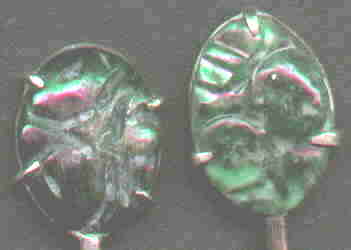
Dark green jade is often referred to as the "emperor's stone". The trade consider it to be the most valuable, but I often prefer other colors and I particularly like jade with a mix of colors (particularly yellow and red). Of course, likes and dislikes in colored stone changes over the generations and is often based upon cultural and personal preferences.
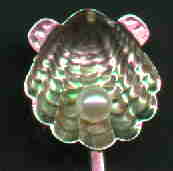
Real cultured pearl mounted in a simulated silver oyster shell. The Japanese pioneered and are still the largest producers of cultured pearls in the world.
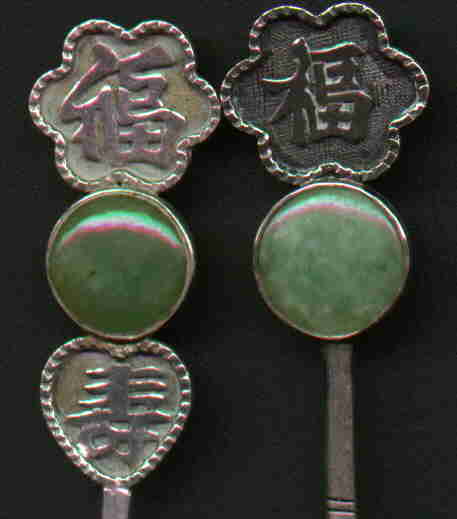
Jade is considered to be a "good luck" stone and is often used with other symbols of good luck. The top finials refer to "long life" and the heart is a symbol for love as it is in our culture. More good luck spoons may be seen in the two exhibits which are available from the main index.
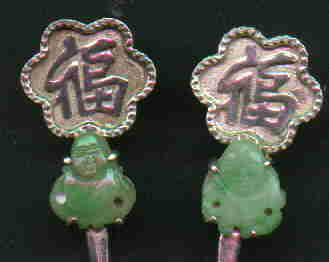
Carved gem Buddha's under a "long life" symbol. Note the two holes. These stones were originally designed to be used as jewelry.

"egg" shaped carved jade stones. I am assuming that the orientals attribute this shape to birth and the renewal of life as we do (but I could be wrong). Use the bar at the bottom to see the picture on the right. The "pink" is a reflection of the scanner light, and not on the stone.
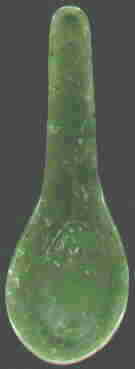
This spoon is entirely carved from one piece of nephrite (jade) or possibly serpentine. The stone is carved very thin in the old style--it is almost possible to see light through it
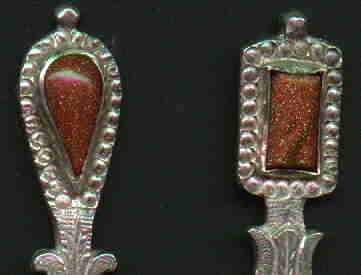
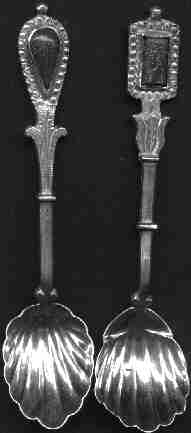
These hand made spoons are decorated with "goldstone". Goldstone is a man-made stone which sparkles and is very pretty. A very experienced silver dealer told me the following story: "Originally goldstone was a secret formula in one of Japan's monestaries. The monks used it for "income". Later the secret formula became known and it is now produced commercially". I suspect that these spoons are from the early production. Dorothy Rainwater has pictured a spoon similar to the left one in her book but she has identified the spoon as being "tigereye" (#1469-since her picture is B&W I can't be sure of exactly what she has pictured). She has attributed it to India.



nephrite jade finials on these three hand made spoons.
The leaf bowls are very interesting variations

The finial on this spoon is a large piece of lapis lazuli. The spoon is unmarked thus I can't be exactly sure of where it was made, but much of the good quality lapis comes from Afganistan as it has for the last 5,000 years. Lapis lazuli is a beautiful blue stone which often has pieces of iron pyrite embedded in it. The ancient caravans from Asia often used it for trade and lapis from Afganistan is found in ancient Egyptian Pharoah jewelry as well as throughout the ancient cultures of the Mid-East and in ancient Greece and Rome. The stone is mentioned in the Bible many times. During the Renaissance era, lapis was ground into a fine powder and was used as the pigment for blue color paint by all of the famous artists of Europe.
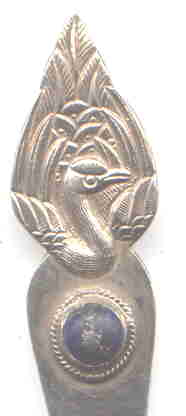
This spoon also has a nice piece of lapis lazuli mounted on it. In addition the lapis has a nice large piece of iron pyrite in the center of the stone. The swan is a nice touch. marked "silver" with oriental touchmarks
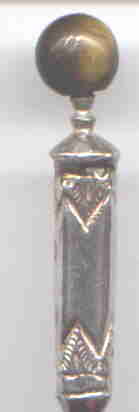

This is an unusual hand made spoon featuring a cats eye stone at the top. There are no markings to identify the source of the spoon or purity of the metal, but it looks like silver to me and I suspect that it is of Southeast Asian manufacture. The top of the handle is hollow and probably represents some type of religious article (I think) and the hand pounded bowl is very deep. The stone, itself, has a yellow section with fair chatoyancy, but it also has a darker section which is not as pretty.
Proceed to next Gemstone exhibit
Return to Gemstone index
Chinese Good Luck Spoons Exhibit also has jade spoons exhibited
Return to Spoon World index